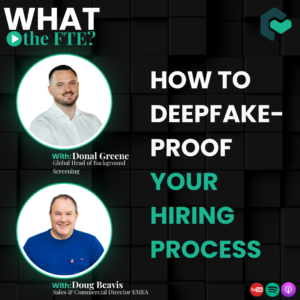The way we talk about leadership is tired.
We’ve glamourized hustle, rewarded detachment, called burnout a badge of honour. I’m guilty of all this.
This week’s guest, Anitta Krishan, shares how burnout in the tech trenches led her to breathwork, Bali, and a whole new philosophy of leadership that’s gaining serious traction: embodied leadership.
Anitta is the Chief Culture Officer at Hoogly and former VP, Global Head of People & Strategy at TikTok and she stopped by the pod to share her refreshing take on modern leadership that’s gaining momentum: embodied leadership.
What’s Embodied Leadership (and Why HR Should Care)?
You’ve probably heard of emotional intelligence. Anitta introduced me to its grounded, breath-of-fresh-air cousin: embodied leadership.
According to Anitta, it’s not just what you know as a leader, it’s how you show up. Embodied leadership is all about leading with your full self… yes body, mind, and nervous system included. (And yes, it’s backed by neuroscience and somatic psychology.)
Where Did Embodied Leadership Come From?
The roots of embodied leadership go back to somatic leadership practices from the 1990s, especially through the work of Richard Strozzi-Heckler and the Strozzi Institute, which combined martial arts, neuroscience, and leadership coaching.
It’s since been embraced by exec coaches, forward-thinking HR teams, and leaders burned out by the performative grind.
Embodied leadership is backed by:
- Neuroscience (regulating stress and decision making)
- Mirror neurons (leaders set emotional tone)
- Somatics (stress lives in the body, not just the mind)
- Performance science (self-aware leaders drive engagement)
How Does Embodied Leadership Work?
As we get into on pod, it starts with self-leadership: better sleep, breathwork, mindfulness, and knowing how to work with your nervous system, not against it. It’s Anitta’s recipe for less burnout and more bandwidth.
Anitta’s path—scaling TikTok to 50,000 employees before walking away—mirrors what many HR leaders and founders I’ve talked to feel: success that looks great on paper but leaves your nervous system in shambles. “I was keeping tech bros happy,” she jokes. “But what was I doing for me?”
Importantly, embodied leadership isn’t just personal wellness repackaged, though we can all benefit from self-care. I now understand it as the difference between “reading a room” and actually feeling the energy shift when someone’s disengaged, between saying “I hear you” and actually being present.
Anitta explains that leaders who are emotionally regulated make clearer decisions, foster deeper team trust, and avoid reactive management styles that alienate talent.
Embodied leaders practice things like:
- Self-regulation: Staying calm when stuff hits the fan (AKA not sending that spicy Slack message right away
- Presence: Actually listening, not just waiting for your turn to talk
- Energy awareness: Knowing when the team’s flat and when they’re fired up and adjusting your approach accordingly
Why Embodied Leadership Matters Now
Post-pandemic, HR leaders are seeing a massive shift; traditional leadership development isn’t cutting it. In fact, McLean & Company’s 2025 Employee Engagement Trends Report points to “emotional regulation and authentic leadership presence” as key engagement drivers, especially for middle managers.
So no, embodied leadership isn’t fluff. It’s what high-impact, human-first leadership looks like in the AI age. That’s the message from Anitta.
The Burnout We Don’t Talk About
Employee engagement has reached a decade low, according to Gallup, and HR professionals are bearing the brunt of it. According to SHRM’s 2025 State of the Workplace Report, In 2024, 62% of HR professionals reported that their departments have been operating beyond typical capacity, an increase from 57% in 2023. Similarly, 57% stated that their department lacked sufficient staff for its workload, consistent with 2023’s findings (56%).
The challenges don’t stop there.
Lattice’s 2025 State of People Strategy Report reveals a significant disconnect between HR teams and executive leadership. Only 39% of HR teams report that they’re actually able to execute action plans for engagement, leaving 61% of teams without the resources or support to make meaningful progress.
Sorry, it gets worse.
The integration of AI into HR functions is progressing slowly. While 90% of CHROs anticipate AI becoming more prevalent in the workplace, only 35% of HR leaders believe their current HR technology effectively supports business objectives.
This disconnect isn’t about tools; it’s fundamentally about people and, more precisely, how we lead them. As we navigate the complexities of modern work environments, there’s clearly a pressing need to reevaluate leadership approaches. Good thing Anitta and Hoogly are on the case.
From Surveys to Real-Time Culture OS
Through her work at Hoogly, Anitta is building what she calls a “culture operating system,” replacing annual surveys with real-time insights powered by empathetic, conversational AI. It’s very cool.
Without surveying, Hoogly finds out about employee sentiment, how things are going, and in real time, the managers get coaching around how to act on this feedback. The platform coaches middle managers (the most overwhelmed tier in org charts backed up by Melissa’s research on the impact of first-level managers) to act on culture issues before they cause attrition.
Anitta points out that it’s not just innovation for innovation’s sake, but in direct response to what HR data tells us: speed, coaching, and connection beat bloated, delayed survey cycles every time.
What HR Can Do Now
Admittedly at first I thought this sounded a bit out there, but now I realize it’s not, it’s timely. It’s grounded in science, and it’s what the best HR teams are already doing:
- Rethink Engagement: Move beyond pulse surveys to connection metrics. Weekly check-ins, manager touch points, and AI-enabled sentiment tracking are more effective than annual reports.
- Coach the Middle: Empower middle managers with real-time coaching and insights. They’re the make-or-break point for culture, retention, and engagement. I highly suggest digging into Melissa’s take on The Leadership Blind Spot That’s Hurting Your Business.
- Embrace Embodiment: Offer leadership training that includes mindfulness, somatic awareness, and mental fitness, not just performance KPIs.
- Lead the Redesign: As AI reshapes how we hire, HR must redesign what great leadership looks like. (It’s not just about output.)
Final Word on The Future of Work
I talk a lot about the “future of work” (I have a whole podcast on it 😅). But Anitta calls it something better: the next era of work. Touché.
She challenges us to move beyond the relentless pursuit of speed and instead build workplaces grounded in connection and human-first impact.
🎧 Tune in to the full episode here: certn.co/podcast
—
Want more insights like this?
🔗 Browse the full catalogue of What the FTE? episodes
📩 Sign up for the weekly newsletter to get the good stuff straight to your inbox
P.S. Building a high-performance, remote team? Certn’s background checks won’t slow you down. 👉 Start screening in minutes—not weeks.





